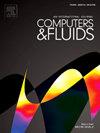Incremental singular value decomposition based model order reduction of scale resolving fluid dynamic simulations
IF 2.5
3区 工程技术
Q3 COMPUTER SCIENCE, INTERDISCIPLINARY APPLICATIONS
引用次数: 0
Abstract
Scale-resolving flow simulations often feature several million [thousand] spatial [temporal] discrete degrees of freedom. When storing or re-using these data, e.g., to subsequently train some sort of data-based surrogate or compute consistent adjoint flow solutions, a brute-force storage approach is practically impossible. Therefore, – mandatory incremental – Reduced Order Modeling (ROM) approaches are an attractive alternative since only a specific time horizon is effectively stored, usually aligned with the amount of fast available, e.g., Random Access Memory (RAM). This bunched flow solution is then used to enhance the already computed ROM so that the allocated memory can be released and the procedure repeats.
This paper utilizes an incremental truncated Singular Value Decomposition (itSVD) procedure to compress flow data resulting from scale-resolving flow simulations. To this end, two scenarios are considered, referring to an academic Large Eddy Simulation (LES) around a circular cylinder at as well as an industrial case that employs a hybrid filtered/averaged Detached Eddy Simulation (DES) on the flow around the superstructure of a full-scale feeder ship at .
The paper’s central focus is on an aspect of severe practical relevance: how much information of the computed scale-resolving solution should be used by the ROM, i.e., how much redundancy occurs in the resolved turbulent fluctuations that favors ROM. In the course of the tSVD employed, this goes hand in hand with the question of ”how many singular values of the flow-solution-snapshot-matrix should be neglected (or considered)” – without (a) re-running the simulation several times in a try-and-error procedure and (b) still obtain compressed results below the model and discretization error. An adaptive strategy is utilized, which features two comparatively simple adjusting screws, for which appropriate decision support is provided. Next to a general feasibility study, reported results show the capability to obtain a fully adaptive data reduction of percent via a computational overhead of percent with a mean accuracy of reconstructed local and global flow data of percent.
基于增量奇异值分解的模型降阶求解流体动力学模拟
尺度解析流模拟通常具有数百万[数千]个空间[时间]离散自由度。当存储或重用这些数据时,例如,随后训练某种基于数据的代理或计算一致的伴随流解决方案,暴力存储方法实际上是不可能的。因此,强制性增量-降阶建模(ROM)方法是一种有吸引力的替代方法,因为只有特定的时间范围有效存储,通常与快速可用的数量保持一致,例如随机存取存储器(RAM)。然后使用这种束流解决方案来增强已经计算的ROM,以便可以释放分配的内存并重复该过程。本文利用增量截断奇异值分解(itSVD)方法对尺度解析流场模拟所得的流场数据进行压缩。为此,研究人员考虑了两种情况,一种是在ReD=1.4⋅105时围绕圆柱体进行的学术大涡流模拟(LES),另一种是在ReL=5.0⋅108时采用混合滤波/平均分离涡流模拟(DES)的工业案例。本文的中心焦点是一个严重的实际相关的方面:计算出的尺度解析解中有多少信息应被ROM使用,即在有利于ROM的已解湍流波动中出现了多少冗余。这与“应该忽略(或考虑)多少流动解决方案快照矩阵的奇异值”的问题密切相关-没有(a)在试错过程中多次重新运行模拟,(b)仍然获得低于模型和离散化误差的压缩结果。采用了一种自适应策略,该策略具有两个相对简单的调节螺钉,并为其提供适当的决策支持。在一般性可行性研究之后,报告的结果表明,通过O(10) %的计算开销,重构局部和全局流量数据的平均精度为O(10−3−10−1)%,能够获得O(95) %的完全自适应数据缩减。
本文章由计算机程序翻译,如有差异,请以英文原文为准。
求助全文
约1分钟内获得全文
求助全文
来源期刊

Computers & Fluids
物理-计算机:跨学科应用
CiteScore
5.30
自引率
7.10%
发文量
242
审稿时长
10.8 months
期刊介绍:
Computers & Fluids is multidisciplinary. The term ''fluid'' is interpreted in the broadest sense. Hydro- and aerodynamics, high-speed and physical gas dynamics, turbulence and flow stability, multiphase flow, rheology, tribology and fluid-structure interaction are all of interest, provided that computer technique plays a significant role in the associated studies or design methodology.
 求助内容:
求助内容: 应助结果提醒方式:
应助结果提醒方式:


